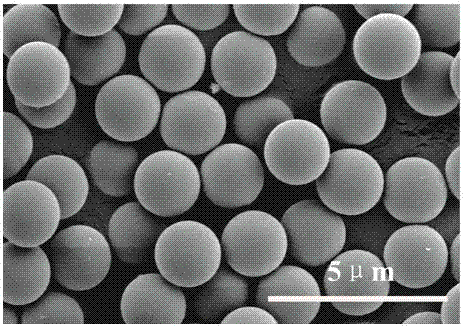A kind of method for preparing mesoporous silica core-shell microspheres
A technology of mesoporous silica and core-shell microspheres, applied in the direction of silica, silica, etc., can solve the problems of reducing the effective surface area of chromatographic applications, prone to agglomeration, and affecting separation efficiency, so as to achieve easy control and amplification, The effect of simple preparation process and mild conditions
- Summary
- Abstract
- Description
- Claims
- Application Information
AI Technical Summary
Problems solved by technology
Method used
Image
Examples
Embodiment 1
[0038] Example 1 Preparation of micron-sized surface porous silica core-shell microspheres ( figure 1 )
[0039] (1) Preparation of solid silica microspheres
[0040] According to the reference [H. Nakabayashi, A. Yamada, M. Noba, Y. Kobayashi, M. Konno, D. Nagao, Langmuir 26 (2010) 7512-7515] to prepare micron-sized silica solid microspheres, a typical method Preparation of solution A: Take a clean reagent bottle, add 200-300 mL of absolute ethanol, an appropriate amount of water and ammonia, and an appropriate amount of electrolytes to make a 300 mL mixed solution, ultrasonic for 10 minutes for use.
[0041] Preparation of solution B: Add an appropriate amount of TEOS to a certain amount of absolute ethanol to make a diluted solution, and ultrasonicate for 10 minutes for use.
[0042] Add liquid A to a 1000 mL three-necked flask, control the dropping rate to be less than 0.8 mL / min, slowly add liquid B, and react at an appropriate temperature with a certain stirring speed. After the...
Embodiment 2
[0047] Disperse 0.1 g of solid silica gel microspheres in Example 1 into 40 mL of deionized water for ultrasonic dispersion, and then disperse 0.74 g of cetyltrimethylammonium bromide (CTAB) and 0.46 g of trioctylmethylammonium bromide (TOMAB). ) Template is dispersed into a mixture of 80 mL ethanol and water (V water :V Ethanol =1:1), ultrasonically disperse uniformly, then add to the silicon core suspension, stir for 30 min, add 1 mL of ammonia (25 wt%) dropwise at room temperature, stir for 30 min, add 20 drops at a rate of 0.2 mL / min mL of TEOS solution (1-5% ethanol solution), react for 6 h at room temperature after the addition is complete. After the reaction, the obtained product was washed repeatedly with deionized water and ethanol. Finally, the resulting product was dried at 60°C for 6 hours, and then the resulting product was placed in a muffle furnace and calcined at 600°C for 10 hours. The obtained core-shell microspheres have an average pore diameter of 10.60 n...
Embodiment 3
[0050] Disperse 0.1 g of solid silica gel microspheres in Example 1 into 40 mL of deionized water for ultrasonic dispersion, and then mix 0.54 g of cetyltrimethylammonium bromide (CTAB) and 0.66 g of trioctylmethylammonium bromide (TOMAB). ) Is dispersed into a mixture of 80 mL of ethanol and water (V water :V Ethanol =1:1), disperse uniformly by ultrasonic, then add to the silicon core suspension, stir for 30 min, add 1 mL of ammonia (25 wt%) dropwise at room temperature, stir for 30 min, add 20 drops at a rate of 0.2 mL / min mL of TEOS solution (1-5% ethanol solution) was added dropwise and reacted at room temperature for 6 hours. After the reaction, the obtained product was washed repeatedly with deionized water and ethanol. Finally, the resulting product was dried at 60°C for 6 hours, and then the resulting product was placed in a muffle furnace and calcined at 600°C for 10 hours. The average pore size is 6.37 nm.
PUM
| Property | Measurement | Unit |
|---|---|---|
| pore size | aaaaa | aaaaa |
| size | aaaaa | aaaaa |
| pore size | aaaaa | aaaaa |
Abstract
Description
Claims
Application Information
 Login to View More
Login to View More - R&D
- Intellectual Property
- Life Sciences
- Materials
- Tech Scout
- Unparalleled Data Quality
- Higher Quality Content
- 60% Fewer Hallucinations
Browse by: Latest US Patents, China's latest patents, Technical Efficacy Thesaurus, Application Domain, Technology Topic, Popular Technical Reports.
© 2025 PatSnap. All rights reserved.Legal|Privacy policy|Modern Slavery Act Transparency Statement|Sitemap|About US| Contact US: help@patsnap.com



